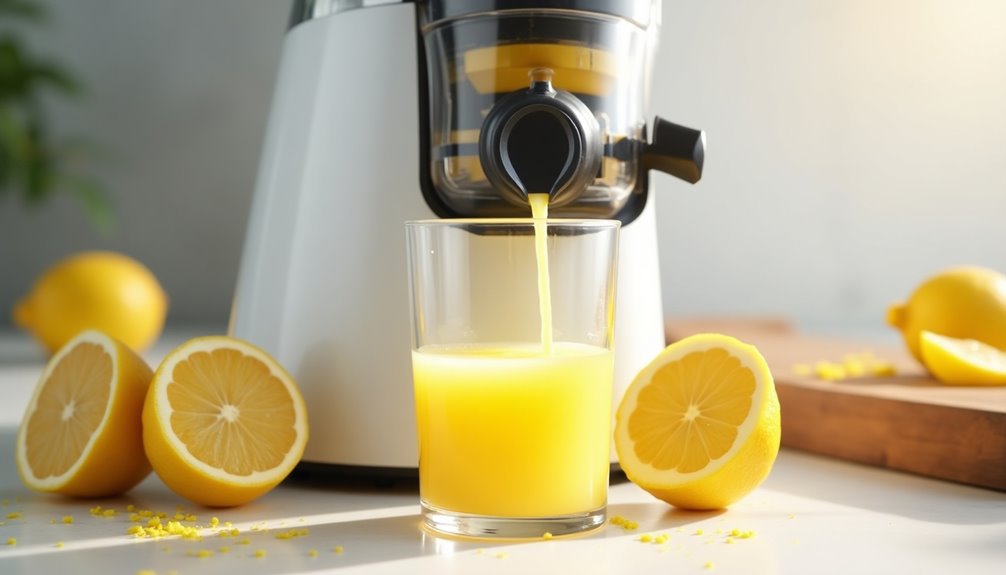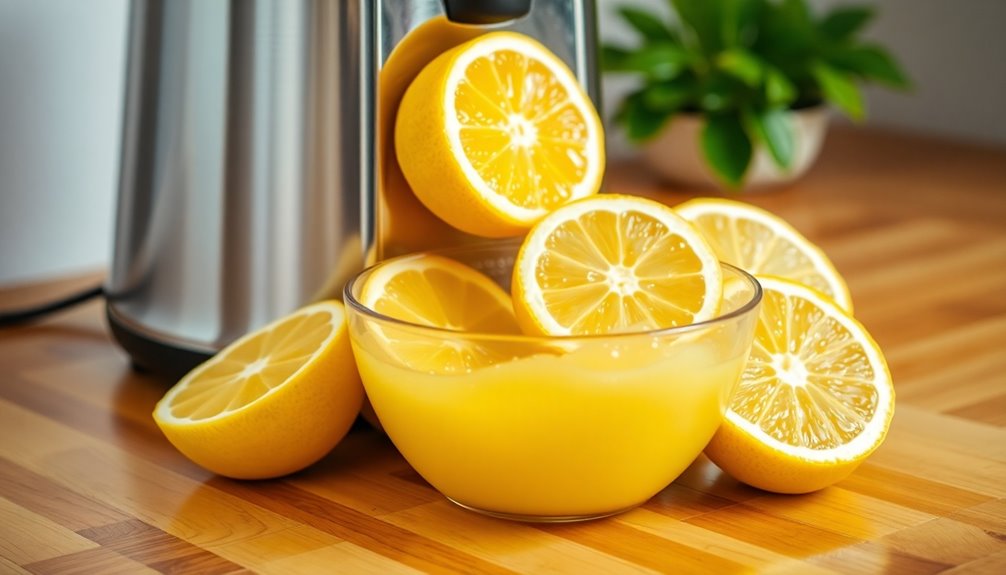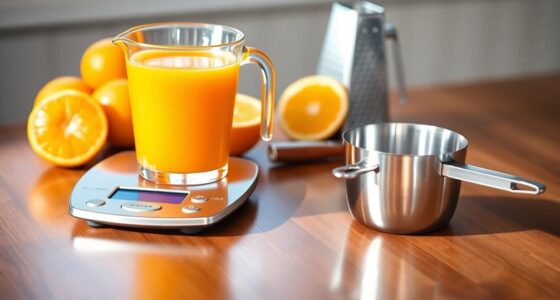To juice lemons in an electric juicer, first, assemble your juicer and cut each lemon in half. Place the cut side down on the reamer and press firmly to extract the juice. You can expect about 1/3 cup of juice per lemon. For more juice, use plump lemons and juice multiple at once. After juicing, strain the juice if desired and clean your juicer components for the next use. There's more to discover about the juicing process!
Key Takeaways
- Assemble the electric juicer, using the smaller reamer for lemons and a mesh filter to catch seeds.
- Cut each lemon in half before placing the cut side down on the reamer for juicing.
- Press down firmly on the lemon to extract juice, expecting about 1/3 cup per lemon.
- Strain the juice if desired to remove pulp and seeds, enhancing the texture.
- Clean the juicer parts with warm, soapy water and let them dry before reassembling.

Juicing lemons can be a breeze when you use an electric juicer, especially if you follow a few simple steps. First things first, grab your citrus juicer and make sure it's properly assembled. You'll want to use the smaller reamer designed specifically for lemons and have the mesh filter in place. This filter is essential for catching any seeds, ensuring you get pure juice without any unwanted bits.
Once your setup is ready, it's time to get to work. Start by taking a fresh lemon and cutting the fruit in half. You might be surprised by how much juice you can extract from just one piece of fruit. Place one half onto the motorized reamer of your juicer. Make sure to face the cut side down; this way, you'll juice right into the collection container.
With the lemon positioned correctly, press down firmly on the lemon half. The juicer will automatically activate when it detects the pressure, making the process even easier. As you press, you'll notice how the stainless steel reamer efficiently extracts the juice. You can expect to yield about 1/3 cup of juice from each lemon, although this can vary slightly depending on the size and juiciness of the fruit.
If you have particularly plump lemons, you might end up with even more juice! This is a great way to ensure you have enough for your recipes or drinks without any hassle. Once you've extracted all the juice from that lemon half, repeat the process with the other half. You'll want to press down until you can't get much juice out anymore.
If you're feeling adventurous, you can even juice multiple lemons in one go, just keep in mind how much juice you need. After juicing, remember to strain the juice if you want to remove any pulp or seeds that might've gotten through. This step is optional but can make a difference in the texture of your final product.
After you've finished juicing, you'll be pleased to know that cleaning up is just as simple as the juicing process itself. The components of the electric juicer can be easily disassembled, making it a breeze to clean each part. Just rinse the reamer and the collection container in warm, soapy water, and they'll be ready for your next juicing session.
Frequently Asked Questions
Do I Have to Peel Lemons Before Juicing?
You don't have to peel lemons before juicing them. In fact, the skin can actually enhance the flavor by retaining essential oils.
Just cut the lemon in half and press it down in your juicer. The juicer's design ensures you'll get plenty of juice without the bitterness being a significant issue.
Plus, the mesh filter keeps seeds out, making your juicing process easier and more efficient. Enjoy that fresh lemon juice!
Can You Juice Whole Lemons in a Juicer?
You can juice whole lemons in a juicer, but it's not the best idea. Whole lemons may clog the juicer with seeds and skin, which can hinder the process.
It's better to cut them in half for smoother extraction and to protect your juicer's motor. Plus, halving the lemons helps you get the most juice out of them.
Don't forget to clean the juicer parts afterward for optimal performance!
What Is the Best Way to Juice Lemons?
Juicing lemons is like squeezing sunshine into a glass. To get the best yield, start by rolling the lemons on the counter to break down the membranes.
Then, cut them in half and either use a handheld squeezer or an electric juicer. If you want even more juice, try microwaving the lemons for 15-20 seconds before juicing.
This way, you'll maximize your juice and make your drinks burst with flavor!
Do You Zest Lemons Before or After Juicing?
You should zest lemons before juicing them. By zesting first, you capture the lemon's vibrant flavor and aromatic oils, which enhance your recipes.
If you juice first, the zest becomes tricky to remove, and you might lose some of that potent flavor. Use a microplane or zester to carefully remove the zest, avoiding the bitter white pith.
This way, you'll maximize the lemon's taste in whatever dish or drink you're making.
Conclusion
Juicing lemons in an electric juicer not only saves you time but also maximizes the juice yield. Did you know that one medium lemon can produce about 2 to 3 tablespoons of juice? By using an electric juicer, you can easily extract every drop, making it perfect for drinks, dressings, or marinades. So, the next time you need fresh lemon juice, grab your electric juicer and enjoy the delicious flavor and health benefits it brings!
Cindy thoroughly researches juicing trends, techniques, and recipes to provide readers with practical advice and inspiration. Her writing style is accessible, engaging, and designed to make complex concepts easy to understand. Cindy’s dedication to promoting the advantages of juicing shines through her work, empowering readers to make positive changes in their lives through the simple act of juicing.











